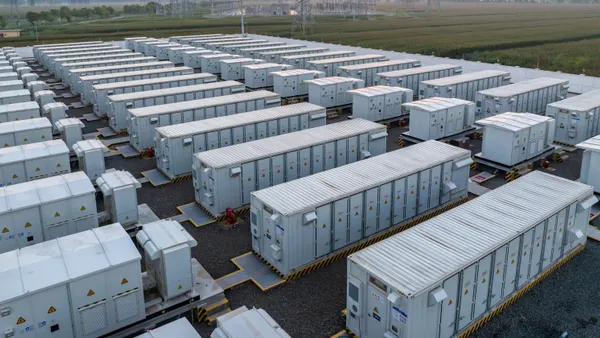Dive Brief:
- The California Independent System Operator (CAISO) is seeing signs of storage resources' ability to shift energy between different times of the day, as the state begins to deploy more and more energy storage systems, a representative for the grid operator said at a regulatory meeting on Monday.
- "We're seeing the kind of performance from storage resources that very much matches what we've envisioned the storage fleet doing in the past… inter-temporal movement of energy from low-priced hours of the day to high-priced hours of the day," Gabe Murtaugh, CAISO's storage sector manager, said at a regulatory meeting Monday.
- Last year, CAISO had around 550 MW of storage on its system; today, that number has grown to a little over 1,500 MW, and is expected to top 3,000 MW by the end of the year, Murtaugh said at the California Energy Commission (CEC) workshop.
Dive Insight:
Storage resources will be a critical component of California's resource mix toward the middle of the decade, experts anticipate, as the state prepares to retire a series of natural gas plants as well as the Diablo Canyon nuclear plant in the coming years. The California Public Utilities Commission (CPUC) this June approved a decision requiring power providers to procure 11.5 GW of clean energy resources to meet expected grid needs, and regulators are now analyzing whether to also authorize the procurement of additional natural gas.
As part of that analysis into reliability needs for the middle of the decade, energy agencies are taking a closer look at the performance of battery storage resources. California has been adding significant amounts of storage to the grid in recent months; on July 16, the state hit a milestone where for a five-minute period, batteries provided a gigawatt of electricity to the grid.
The increase in storage on the grid is "impressive," Murtaugh said, "and at the ISO, we're trying our best to stay on top of this and make sure we're managing the resources properly."
However, CAISO does have some concerns that rules like the investment tax credit (ITC), or some property taxes on storage resources, effectively restrict their ability to "grid charge," or take energy directly off the grid, according to Murtaugh.
This is essentially an "unfortunate consequence" of how the ITC is structured, Jin Noh, policy director with the California Energy Storage Alliance (CESA), told Utility Dive — in order for battery systems to qualify for the credit, they have to be charged by the paired renewable energy system more than 75% of the time. But there could be periods when the grid operator considers it more optimal for these resources to be able to charge from the grid, rather than the system it is paired with.
"We just would like to ask the commission … to the extent that we can, if there are rules that we're putting in place to incentivize or encourage storage build-out, that we don't create other byproducts of those rules that could cause perverse incentives when those resources are trying to participate in our markets," Murtaugh said at the meeting.
And as California ramps up to thousands more megawatts of storage resources, it will start to see differences in how the market operates, Murtaugh said.
"We still start to see a shift from needing four-hour duration batteries, which are just fine for our needs today, to longer-duration batteries" of up to 10 hours, and potentially even multi-day or multi-week storage, he added.
Storage industry players, meanwhile, say that California will need to smooth out certain processes in order to rapidly deploy more storage resources. For instance, the state's fragmented local permitting process can present risks to projects, Dan Patry, manager of policy innovation with Fluence, told regulators at the meeting.
Moreover, California is looking for storage resources to come online quickly to meet near-term and medium-term reliability needs, and "the challenges and risks associated with those compressed schedules tend to flow down to technology providers and developers," Patry said.
"You would love to have it be as simple as possible to do business in California to bring this capacity online," he added.
CESA's Noh agreed that California needs to allow more time for procurement to support project development.
"There are certain milestones, certain time periods that we have to take into account in terms of triggering procurement," like interconnecting and permitting processes, Noh said.














